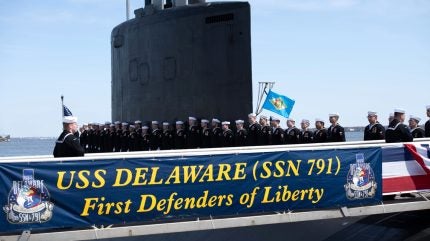
The US Navy’s Virginia-class fast-attack submarine USS Delaware (SSN 791) has achieved a milestone by conducting operations with the Yellow Moray (REMUS 600) uncrewed underwater vehicle (UUV) within the area of responsibility of the US European Command (EUCOM).
This operation is particularly significant as it represents the first instance in which a submarine in a forward-deployed position has successfully launched and recovered a UUV via its torpedo tube to fulfil a tactical mission, as per a Facebook post of the US Commander of Submarine Forces.
The programmed mission profile of the Yellow Moray UUV demonstrated its potential to significantly bolster the Navy’s subsea and seabed warfare (SSW) capabilities.
These operations confirmed the system’s dependability and the capability to undertake multiple missions without requiring divers for deployment and retrieval.
The successful completion of these missions underscores the practicality of deploying robotic and autonomous systems from submarines, thus expanding the scope for covert operations and battlespace preparation.
During the operation, the submarine conducted three separate Yellow Moray UUV missions, each lasting between six to ten hours using the same vehicle.
Commander Submarine Forces vice admiral Rob Gaucher said: “Delaware is just the beginning. We plan to continue to deploy submarines with robotic and autonomous system capability worldwide so we can give more options to our Combatant Commanders by enhancing the capability of our SSNs.
“This capability allows us to extend our reach with additional sensors at both shallower and deeper depths than a manned submarine can access. It reduces risk to the submarine by performing dull, dirty, and dangerous missions with the UUV, and the Yellow Moray system reduces risk to our divers since we can launch and recover via a torpedo tube.”
Integrating Robotic and Autonomous systems with submarines enhances mission possibilities while minimising personnel risk.
These missions encompass seabed mapping, mine detection, and intelligence collection, among others.
The operational independence of UUVs enables them to function in environments that may be inaccessible or too hazardous for crewed submarines, offering valuable data and situational awareness to commanders.
The deployment also showcased the adaptability and problem-solving skills of both the Submarine Force and UUV Group 1.
An initial attempt at launch and recovery in a Norwegian Fjord in February 2025, encountered challenges when the vehicle could not be retrieved after several tries. Upon retrieval by a surface support vessel, technicians identified damage to an essential component. To prevent disruption to the submarine’s deployment schedule, the Submarine Force transported the UUV back to the US for repairs.
After replacing the faulty part, they returned the UUV to the theatre, where USS Delaware successfully executed an expeditionary reload along with numerous successful UUV torpedo tube launch and recovery operations.
As part of this process, the team also conducted a first-ever pierside diver torpedo tube load of the UUV in Norway, providing additional operational flexibility to commanders.
The US Navy’s Virginia-class fleet of fast-attack submarines operate in both open-ocean and coastal waters. These vessels are designed for various roles including anti-submarine warfare, anti-surface ship warfare, surveillance, reconnaissance; irregular warfare; and mine warfare.




